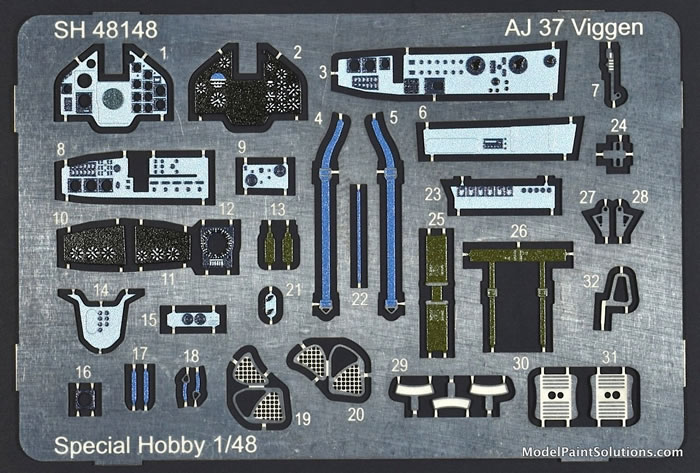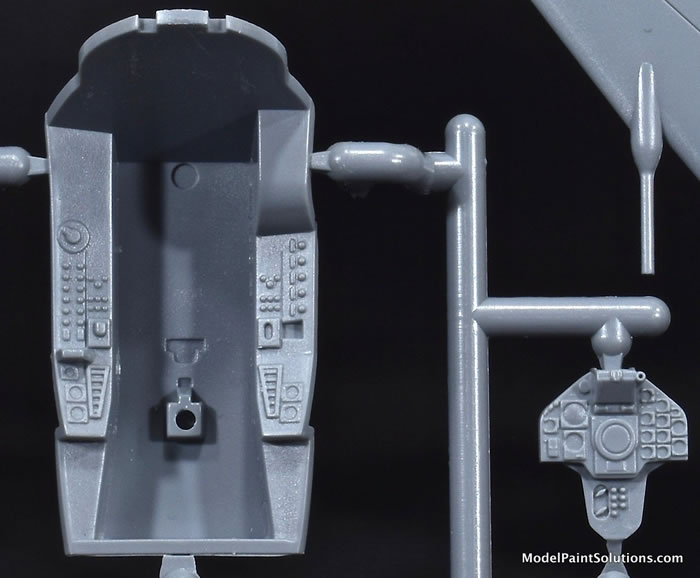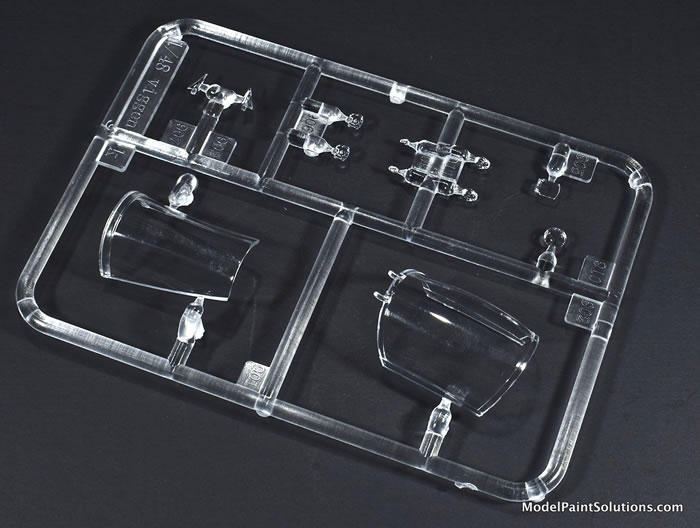Saab AJ 37 Viggen

Special Hobby, 1/48 scale
S
u m m a r y : |
Description and Item No.: |
Special Hobby Kit No. 48148 - Saab AJ 37 Viggen |
Contents and Media: |
162 parts in grey styrene (not all are used), 12 in clear, one fret of colored PE, and one decal sheet with markings for 3 aircraft plus airframe stencils. |
Price: |
GBP£62.99 EU Price (£52.49 Export Price) Plus Shipping at Hannants |
Scale: |
1/48 |
Review Type: |
First Look |
Advantages: |
Scale-appropriate inscribing and surface detail conventional engineering, and a low parts count suggest a relatively quick and easy build. |
Disadvantages: |
None noted. |
Recommendation: |
Being a limited-run kit there’ll be occasional flash and some test fitting of components but the result will be a very detailed model of one of the more distinctive and beautiful aircraft to come from the Saab line. Well done, Special Hobby. |
Reviewed by John Miller

Airfix's 1/72 scale Sea King is available online from Squadron.com
The Saab 37 Viggen ("Thunderbolt”) is a retired Swedish single-seat, single-engine, short-medium range combat aircraft. Development work on the type was initiated at Saab in 1952 and, following the selection of a radical delta wing configuration the resulting aircraft performed its first flight on February 8, 1967 entering service on June 21, 1971. The Viggen was the most advanced fighter jet in Europe until the introduction of the Panavia Tornado in 1981.

Several variants of the Viggen were produced to perform the roles of strike fighter (AJ 37), aerial reconnaissance (SF 37), maritime patrol aircraft (SH 37), and a two-seat trainer (SK 37). In the late 1970s, the all-weather fighter-interceptor aircraft JA 37 variant was introduced. In November 2005, the Viggen was retired from service by the Swedish Air Force, the only operator. It’s replacement was the new Saab JAS 39 Gripen.
(Edited from Wikipedia)
In a rather large lidded box are seven sprues of grey styrene, one clear sprue, one fret of color PE, and one decal sheet with markings for 3 airframes.
The initial response is the size: this is going to be a pretty big kit when assembled. Parts layout and engineering are conventional and the parts count seems low for such a large model. As usual for Special Hobby the inscribed panel lines and surface details are as good as those found on some big production kits (Tamigawa). That said there’s a bit of flash to deal with and extra time will have to be spent cleaning some of the smaller components: par for the course for a limited-run kit.
Assembly begins with the pilot’s office and there is ample detail here right out of the box starting with the 20-piece ejection seat complete with a colored PE harness: very nice.

The cockpit tub is augmented with color photo-etch side panels and a 5-piece color PE instrument panel. This will be a very convincing cockpit when complete.

The completed cockpit along with the engine intake ducting and nose wheel well are then captured between forward fuselage halves. Of note is the inclusion of the large fan blade that will be visible through the engine intakes when assembled.
Next up are the rather prominent thrust reversers that are visible within the engine burner can. The three petal-shaped reversers can be posed in one of three positions: fully open, ground position (partially open), and fully closed. The assembled thrust reverser is then trapped between the rear fuselage halves and the forward (cockpit) and rear (engine) sections are then joined thereby completing the fuselage.

The main wheel wells are separate parts that are added to the full-span lower wing halve. This is offered up to the completed fuselage followed by the left and right upper wing halves: simple and straightforward.
The single-piece left and right engine intakes, the halved nose cone, and the horizontal stabilizer-elevator are added next followed by the multi-part canards largely completing the airframe.
The distinctive main gear with its tandem wheel arrangement is nicely replicated with each assembly (left and right) being comprised of 11 pieces not including wheels and tires.
The kit contains no wing hard points or ordinance. Two different centerline drop tanks (one with three fins, one with four) are provided. The instructions show either tank being fitted however the three-finned tank is apparently appropriate for the AJ variant. (Editors note: Special thanks to “Swemer” for sharing his knowledge on the drop tank versions).
Of note is the option to build the small, wind-driven, emergency generator that’s located on the port fuselage just in front of the leading edged of the wing deployed or closed.
The canopy is nicely molded, crystal-clear, and can be posed open or closed.

Three PE rear-view mirrors that affix to the inner rear frame of the windscreen are included: nice. With the canopy open the nicely detailed cockpit will be easily appreciated and add to what will be a very convincing build.
Markings:
The decals, by Special Hobby, are crisply printed with good color density and registration.

Markings for three airframes and stencil data is provided as follows:
-
AJ 37 Viggen, 7-62, s/n 37062, call sign Gustav 62, F7 Wing, Såtänus, 1990’s.
-
AJ 37 Viggen, 7-22, s/n 37022, call sign Gustav 22, F7 Wing, Såtänus, 1973.
-
AJ 37 Viggen, 15-10, s/n 37051, F15 Wing, Söderhamn, 1978.
-
Airframe Stencils 1
-
Airframe Stencils 2
This Viggen is yet another beautiful kit from Special Hobby and one that I’m just dying to begin. Being a limited-run kit there’ll be occasional flash and some test fitting of components but the result will be a very detailed model of one of the more distinctive and beautiful aircraft to come from the Saab line. Well done, Special Hobby---Highly recommended!
For more on this review visit Modelpaintsolutions.com.
Review kit provided by my retirement fund, again.
Review Text and Images Copyright © 2020 by John Miller
Page Created 21 April, 2020
Last updated
21 April, 2020
Back to HyperScale Main Page
Back to Reviews Page

|
Home
| What's New |
Features |
Gallery |
Reviews |
Reference |
Forum |
Search